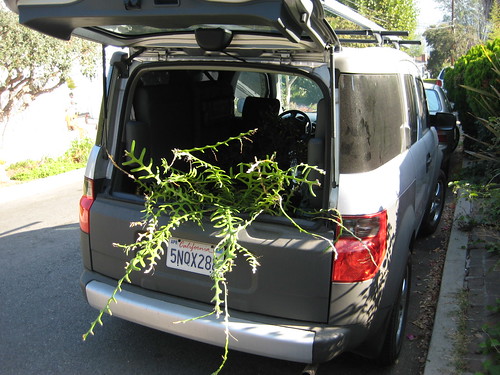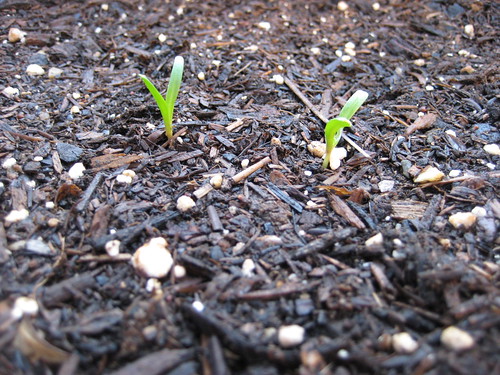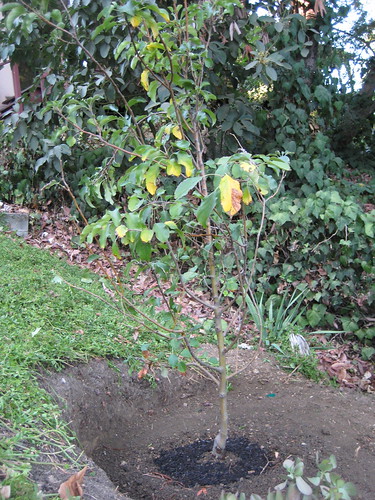Last weekend I spent a lot of time digging around it the dirt. It was great.
My gardening adventures started out bright and early on Saturday morning when the Good Girls went down to EarthWorks Farm for a little volunteering. Merete, Meredith, Jen and I spent a few fun hours spreading manure on farmland that would later be tilled and planted. Maybe manure spreading doesn't sound so great to you, but I had a lovely time. The weather was sunny but cool, and EarthWorks was looking great with fresh, green crops growing everywhere. The farm has really come a long way since the first time we went there. It's very impressive. Plus, manure-spreading is an excellent workout. Meredith and I think it might become the next exercise trend, once pole dancing fades out.
Then, on Sunday, Dakota and I had a gardening windfall on our morning walk with Nigel. A very nice neighbor who is moving to Idaho with his partner offered us all the free plants we could carry. Thinking quickly, we went home, grabbed Dakota's car and started loading up the back.
Since I am an admitted cactus addict, I was happy to score several nice cacti and succulents. In addition, we got two free fruit trees! Our neighbor happily gave us a baby papaya tree that he'd grown with seeds from his own impressive tree, which is fruiting like crazy, and a very cute kumquat in a pot. Since I'm currently in the process of killing/attempting not to kill a second kumquat in the back yard, this healthy tree was much appreciated. Dakota also scored what I think is a staghorn fern. Here it is poking out of the back of his car.
After the big free plant score, I was inspired to do some backyard gardening. So, I planted some more seeds in my winter garden plots. This year I am attempting to grow:
Chard
Beets
Turnips
Spinach
Cabbage
Kale
Arugula
Peas
Carrots
I know that sounds like a lot of vegetables, but I like to try a lot of different types of seeds since my soil is not the greatest. That means I don't get to plant many rows of each vegetable, but that's okay. Luckily, arugula, chard and spinach can all grow in pots. This year's heirloom seeds are from both Seed Savers and Seeds of Change. I am hoping that things go as well as they did last year, or perhaps even better. I sure do love braised turnips straight from the garden. So far, I have only sprouts.
To cap off my gardening weekend, Dakota took a break from ripping out kitchen cabinets to help me dig a hole for the lovely apple tree he gave me for my birthday a couple of weeks ago. It's a semi-dwarf Pink Lady. Pink Lady apple trees were originally developed in Australia, and are supposed to do well in Southern California. Dakota terraced off a little section for it, and we dug the hole very deep and wide to give the roots a good start. I'm hopeful it will survive despite the curse of our backyard and make tasty, pretty apples next Fall.
If I can do a good job with the new apple, papaya and kumquat trees, and keep the older orange, fig and lemon trees alive, we will have quite a nice little orchard. I'm not sure why I've had such a hard time with fruit trees in the past. I guess they require a lot of water to get established, and the last few years have been extremely dry. I also suspect our hard, rocky soil is not helping matters. Here's hoping for a rainy winter.
Framed
4 years ago


I've had issues with our fruit trees too -- we finally admitted we lost a couple and dug them up. We planted about 2 yrs ago. But some are doing well!
Hi! I found you via Homegrown Evolution. I think your free plant is a zig zag cactus (Cryptocereus anthonyanus) you might check out some pictures to see if the leaves look right. It's gorgeous whatever it is!
Here is a good rule of thumb for fruit trees. Plant high on a mound in our heavy Southern California soils. Mulch heavily away around the dripline of the tree. Avoid mulch around trunk. Plant nitrogen fixing shrubs around the base such as pigeon peas etc. Pigeon peas are also edible and are being evaluated as a substitute crop for black eyed peas. On slopes plant trees on a mound with swales below to capture water in lenses. Flood lenses every week. On flat ground deep water every week. Rule of thumb for irrigation is always water low, slow and infrequently. Check out any permaculture texts for examples or google thick mulch for fruit trees. Also, Addition of soil sulfer seems to help in our soils as well.